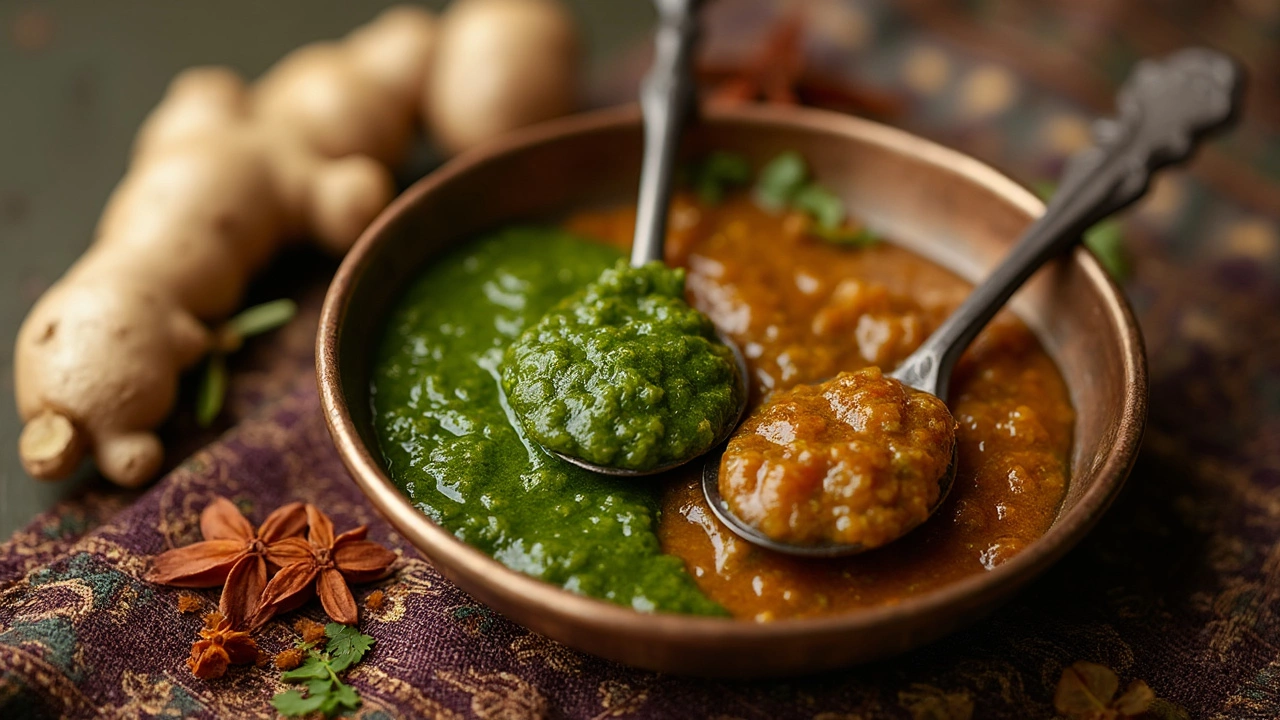Apple Cider Vinegar vs Malt Vinegar in Chutney: Which Works Best?

So you’re halfway through measuring out your ingredients for chutney and—bam!—there’s no malt vinegar in the cupboard. You’re staring at that apple cider vinegar, wondering if it’ll do the trick or if the whole batch is going to end up weird.
No need to panic or run to the store. The kind of vinegar you use makes a real difference, but you’ve actually got more wiggle room than you might think. Apple cider vinegar isn’t just a stand-in; it’s got its own thing going for it. The flavor is a little fruitier and less punchy than malt vinegar, which is why some people actually prefer it in sweeter chutneys.
But before you start swapping, let’s look quickly at what changes—taste, how it interacts with the fruit and spices, and yes, how it can even change the texture after simmering for an hour or two. Ever notice how some chutneys come out a little cloudier or tangier? The vinegar is a big reason for that.
- What Sets Apple Cider and Malt Vinegar Apart?
- How Vinegar Choice Affects Chutney Flavor and Texture
- Smart Swaps: Practical Substitution Tips
- When to Use (or Avoid) Apple Cider Vinegar in Chutney
What Sets Apple Cider and Malt Vinegar Apart?
The main difference between apple cider vinegar and malt vinegar comes down to what they’re made from, and that changes everything: taste, smell, even what they do to your chutney over time.
Apple cider vinegar is made from fermented apple juice. The apple base gives it a fruity kick and a touch of natural sweetness. It’s usually a bit lighter in color and flavor, so it won’t overpower the other ingredients in your chutney. It’s also the go-to vinegar for people who want to avoid gluten—worth knowing if you’re cooking for someone who’s gluten sensitive, because malt vinegar starts with barley or other grains.
Malt vinegar is all about deep, malty notes and a strong, tangy bite. It comes from fermented barley, so it’s cloudier and more robust. That’s why classic chutneys like the kind my mum used to put with cheese and bread usually call for malt vinegar: it stands its ground against sharp spices and strong cheeses.
Here’s a quick head-to-head:
| Apple Cider Vinegar | Malt Vinegar | |
|---|---|---|
| Base Ingredient | Apples | Barley (grain) |
| Flavor | Mild, fruity, slightly sweet | Bold, malty, tangy |
| Color | Golden, clear | Dark brown, cloudy |
| Acidity | Usually 5-6% | Usually 4-5% |
| Gluten Free? | Yes | No |
The key takeaway? If you’re aiming for a classic British-style chutney with a strong, traditional hit, malt vinegar is your best bet. But for lighter, fruitier chutneys or if you need a vinegar substitute that’s gluten-free, apple cider vinegar steps up nicely. Just expect a slightly different kick and a more subtle aftertaste.
How Vinegar Choice Affects Chutney Flavor and Texture
If you swap out malt vinegar for apple cider vinegar in your chutney, the changes are more than just a minor tweak. The main difference starts with taste: apple cider vinegar has a gentler, sweeter kick, while malt vinegar packs more of a classic sharpness. This means your chutney could end up tasting a bit fruitier, or even slightly less tangy than what grandma used to make. If you’re all about those deep, bold flavors, you might miss the bite that malt brings. But if you’re aiming for a mellow, slightly tart chutney, apple cider vinegar can actually make the experience more rounded.
Texture’s another thing to think about. Malt vinegar is darker and a bit thicker, so chutneys often look richer and may come out thicker after simmering. Apple cider vinegar is lighter, which sometimes gives chutney a brighter color and a touch more liquid—especially if you don’t cook it down long enough. Want a chunkier chutney? Just let it bubble a little longer if you’re using apple cider vinegar.
There’s also something about aroma—cider vinegar has this apple note in the background. For some chutney fans, it adds a little something special, especially with fruits like mango or peach. But if you’re using it in a classic tomato or onion chutney and you want the old-school flavor, that apple scent might not blend as well as you'd hope.
The bottom line: both vinegars will preserve your chutney just fine, but the final taste and texture will be influenced by the swap. Thinking about who’ll be eating it—whether they like things tangy or sweet—can help you decide which vinegar to use.

Smart Swaps: Practical Substitution Tips
Running out of malt vinegar happens more often than you’d think—so here’s what smart home cooks do when it’s crunch time. First up, let’s just say it: swapping in apple cider vinegar works in about 90% of sweet or fruity chutney recipes. The taste will be milder and a touch fruitier. Vinegar strength matters, too: most malt vinegar sits at 5% acetic acid, just like standard apple cider vinegar, so you won’t mess up the preserving power.
But there are a few things to keep in mind to nail the flavor and not end up with a watery or over-sharp chutney. Check out these steps:
- Use apple cider vinegar in a 1:1 ratio for malt vinegar—no fancy math needed.
- If your chutney leans on richer, earthy spices (think garam masala, brown mustard seed), add an extra pinch—apple cider vinegar is softer, so spices can get a little lost.
- For tangier results, you can blend apple cider vinegar with a tablespoon or two of lemon juice.
- If your recipe calls for a dark, strong malt vinegar, consider adding a teaspoon of molasses or brown sugar to deepen the flavor and get that little bit of malty backbone.
It’s also smart to know how the two vinegars compare in cooking. Here’s a quick breakdown:
| Vinegar | Acidity | Typical Flavor | Best Use in Chutney |
|---|---|---|---|
| Apple Cider Vinegar | 5% | Mild, fruity, tangy | Sweet, fruit-based chutneys |
| Malt Vinegar | 5% | Bold, malty, sharp | Traditional, spicy, or savory chutneys |
One of the old-school British chutney makers once told The Guardian,
"If you’re using a softer vinegar like apple cider, you get a rounder, less aggressive tang—go for it when you want the fruit to shine."
Just don’t use apple cider vinegar if someone in the house is fussy about that apple-y smell, or if you’re making a batch for very traditional tastes—some folks really miss that robust malt kick. For everybody else? You’ll probably be surprised how well it works and how easy it is to tweak the flavor back to what you want.
When to Use (or Avoid) Apple Cider Vinegar in Chutney
There are times when using apple cider vinegar in chutney is a solid move—and then there are moments when it just doesn’t work. Knowing the difference helps you avoid bland or off-tasting results.
So, when should you actually reach for that bottle? If you’re making a fruit-based chutney (think apple, pear, or mango), apple cider vinegar plays well with natural sweetness. It adds a mild tang and a hint of fruitiness, which balances out sugar and makes the flavors pop. For spicy chutneys, like ones with lots of chilies or assertive spices, apple cider vinegar softens the heat a bit and gives things a smoother finish.
- If you want a chutney that’s kid-friendly or not as sharp, use apple cider vinegar.
- If you’re out to highlight the actual fruit flavor, cider vinegar does the job.
- Got dietary needs? Apple cider vinegar is usually gluten-free, while malt vinegar isn’t—handy for gluten-free kitchens.
On the flip side, malt vinegar brings a stronger, richer flavor with a bit more bite. That’s why it shines in old-school recipes, especially with savory or onion-based chutneys. Apple cider vinegar can leave these more ‘robust’ chutneys a little flat, almost too mellow, and the color might come out paler or cloudy.
- Skip apple cider vinegar if you’re after that classic British chutney punch.
- If you want deep brown color and an unmistakable tang (like those jars served in pubs), stick with malt vinegar.
Here’s a quick comparison to help you decide:
| Chutney Type | Best Vinegar | Why? |
|---|---|---|
| Fruit (apple, mango, peach) | Apple cider vinegar | Brings out sweetness, mild tang |
| Onion or tomato | Malt vinegar | Strong flavor, traditional color |
| Spicy/chili-based | Apple cider vinegar | Mellows spice, easy on the palate |
| Mixed veg | Malt vinegar | Richer taste, classic finish |
If you’re following a family recipe, and it already asks for malt vinegar, expect a little difference if you swap it out—but sometimes that’s an upgrade if you’re after lighter, fruit-forward flavors. My wife Priya grew up using apple cider vinegar in every batch, so in our house, it’s our go-to for mango chutney, but we always go malt for her mom’s onion-tomato mix. Bottom line: you can swap, but know what you’re aiming for.